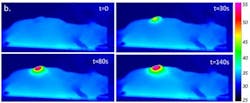Nanotube injection, followed by laser irradiation, softens tumors to improve cancer treatment
Recognizing that the mechanical resistance of tumors and collateral damage of standard treatments often hinder efforts to defeat cancers, a team of researchers from the Centre National De La Recherche Scientifique (CNRS), the French National Institute of Health and Medical Research (INSERM), Paris Descartes University, and Paris Diderot University (all in Paris, France) has softened malignant tumors by heating them, making them more vulnerable to therapeutic agents. The method—called nanohyperthermia—involves directly injecting carbon nanotubes (CNTs) into tumors, followed by laser irradiation to activate them while the surrounding healthy tissue remains intact.
Related: Laser irradiation produces vesicle explosions to mimic cellular reactions
Researchers are increasingly turning their attention to the mechanical factors affecting tumor development. Tumors stiffen because of the abnormal organization of the collagen fibers and extracellular matrix (ECM) that hold cells from the same tissue together. In addition to being a marker of malignancy, such stiffening may help cancer cells proliferate and metastasize. Furthermore, the ECM forms a physical barrier that limits tumor penetration by therapeutic agents. Various treatments attempt to disrupt the structure of tumors, but because ECM is common to tumors and healthy organs, degrading it does as much harm as good.
However, the research team found a way around this problem for mouse tumors. After being directly injected into the tumors, CNTs were activated with near-infrared light. The laser only acts on areas of CNT concentration, heating them up. The researchers monitored tumor stiffness noninvasively using ultrasound shear wave elastography. This technique uses the shear or secondary wave produced by ultrasound to map tissue elasticity. In two consecutive sessions at a day's interval, the tumors were exposed to nanohyperthermia, or localized heating to 52°C for a duration of 3 minutes. Tumors initially became more rigid before gradually softening over the 10 days or so that followed the procedure.
Nanohyperthermia denatures collagen fibers locally and reduces the rigidity and volume of tumors over the long term. It disrupts the tumor microenvironment and may prove effective as an adjuvant treatment with chemotherapy.
Full details of the work appear in the journal Theranostics; for more information, please visit http://dx.doi.org/10.7150/thno.17574.

